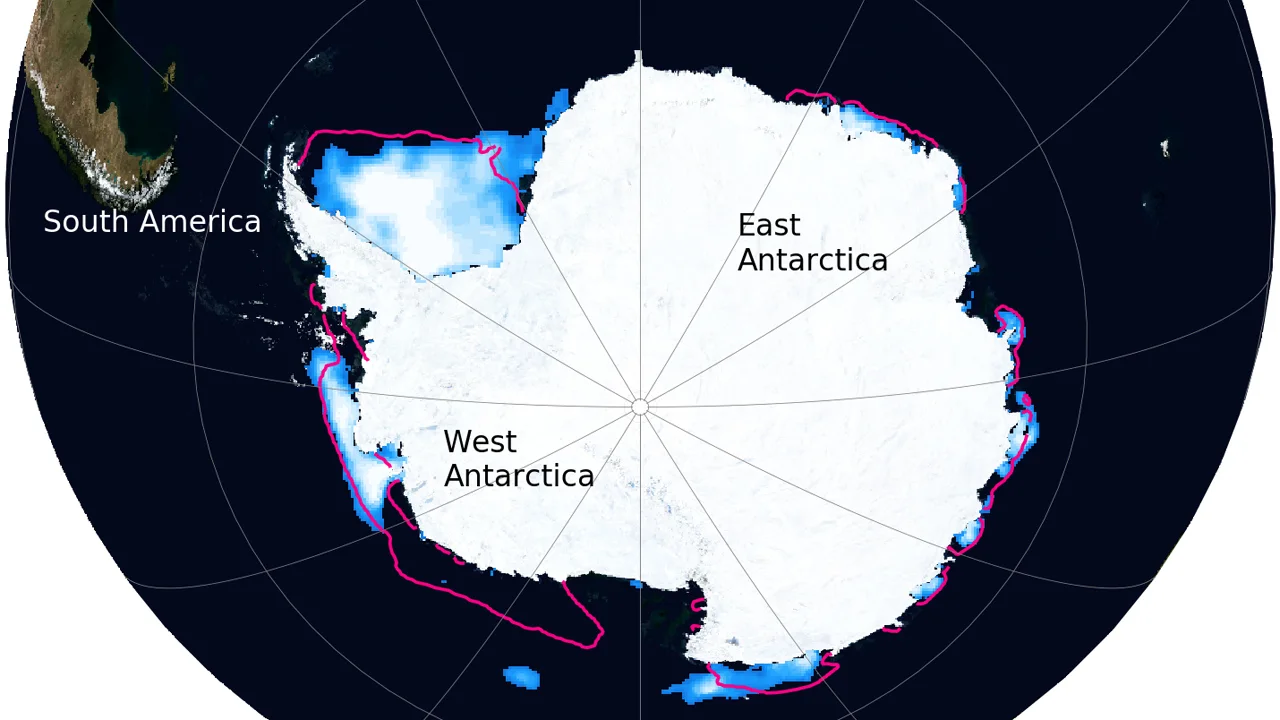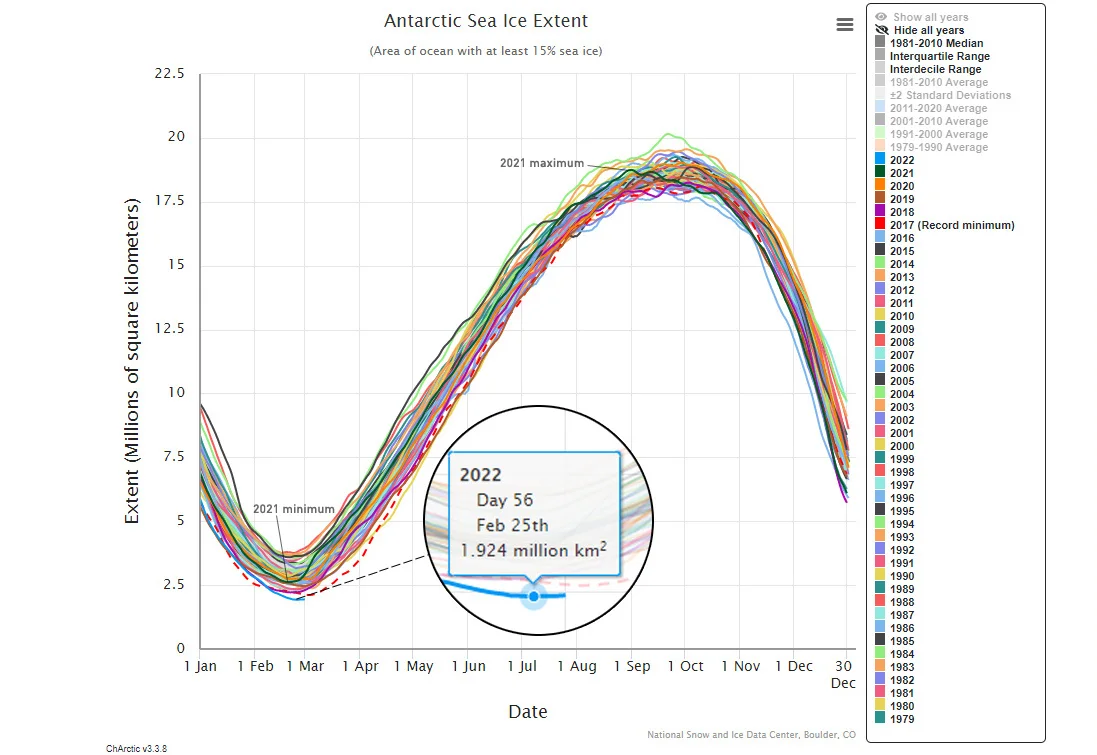
Antarctic sea ice melts away to the lowest summer extent seen on record
It's summer in the southern hemisphere, but at no time in the past four decades has there been less ice seen in the waters around Antarctica.
From their vantage point in space, satellites monitoring sea ice surrounding the continent of Antarctica witnessed the ice melting away this season to the smallest extent seen since record keeping began over 40 years ago.
Antarctic sea ice has been on a bit of a rollercoaster ride over the past year. After a fairly mediocre summer minimum last February, the sea ice extent quickly grew throughout the southern autumn and winter to reach an exceptionally early winter maximum at the beginning of September. At that time, it was in the top five extents seen in the satellite era.
In past years, the ice around Antarctica would have continued to expand for at least another few weeks, reaching a maximum extent in late September. However, after Sept. 1, 2021, the ice instead began to dwindle — slowly at first, but by mid-October the numbers plummeted. Ice extent measured through the rest of the southern spring and into southern summer tracked among the lowest seen so far.

The Charctic interactive sea ice graph plots daily Antarctic sea ice extents from 1979 to 2022, along with the February 25, 2022 record low minimum (inset). Credit: National Snow and Ice Data Center/Scott Sutherland
Typically, the decrease in Antarctic sea ice extent levels off in late January or early February. However, this year, we didn't see that same levelling-off. Instead, the ice continued to melt.
On Feb. 8, Antarctic sea ice extent set a new daily record for the lowest extent ever measured — beating out the previous record lows set back in 2017 and 2018. For over two weeks after, new daily records were set until the melting finally slowed to a halt.

This map plots the average extent of sea ice around Antarctica for the month of February 2022. The inset map shows the extent specifically on February 25, 2022, when the record minimum was logged. Orange areas on the inset map are regions with no data available. Credit: NSIDC/Scott Sutherland
Feb. 25, 2022 now holds the new record for lowest summer minimum extent of Antarctic sea ice since 1979.
"For the first time since the satellite record began in 1979, extent fell below 2 million square kilometers," the National Snow and Ice Data Center wrote in their latest report, "reaching a minimum extent of 1.92 million square kilometers on February 25."
Watch below: One of the largest icebergs on Earth released 152 billion tons of freshwater
Compared to the Arctic, we don't hear about Antarctic sea ice very often.
While the Arctic shows a clear long-term trend of dwindling sea ice, and global sea ice is shrinking as well, the situation in the waters around Antarctica is more complex. Sea ice extent in the Southern Ocean varies much more widely, year to year. Also, yearly minimum extents showed a generally increasing trend from the mid-1990s through the mid-2010s.
The reason for this? Based on the changes we are seeing, it appears that global warming is in the process of turning Antarctic land ice into Antarctic sea ice.
It starts with warming air and water temperatures causing more melting of the glaciers and ice sheets along the continent's coastlines. The freshwater produced from this melting then pours into the ocean, where it floats atop the denser saltwater and quickly refreezes. This additional sea ice is then spread farther away from the coastlines by wind and ocean currents, increasing the overall extent measured by satellites.
However, if ocean temperatures are high enough, it impacts the formation of sea ice. The ice doesn't form as quickly in the fall and winter seasons, and it melts away more quickly in spring and summer. For this reason, climate scientists have been warning that increasing ocean temperatures will eventually take their toll on Antarctic sea ice, just as we are seeing in the Arctic.
"The temperature of the ocean limits how much area the ice can cover," Dr. Marilyn Raphael, director of the UCLA Institute of the Environment and Sustainability and coauthor of new research into Antarctic sea ice published in January, stated in a UCLA press release last month.
"The same thing happened five years ago, when warming and more exposed ocean caused earlier retreat of the ice," Dr. Raphael added.

This graph plots the trends in seasonal Antarctic sea ice minimums, starting 10 years after record-keeping began. The vertical bars reveal the high variability of the extents, but the blue trend line generally indicates if the trends are positive (above the centre line, meaning the ice is still growing) or negative (below the centre line, meaning the ice is declining). Credit: NSIDC
Indeed, as shown in the NSIDC data plotted above, after an initial period of wavering trends, Antarctic sea ice minimums were on a positive trend from 2001-2021. Thus, during that time, minimum extents were on the increase, and the more positive the trend was for any given year, the greater the increase was. However, a shift appears to have taken place from 2015 through 2021. While the trends were still positive over those years, their magnitude dwindled fairly steadily. As of 2022, the trend is very close to zero.
Perhaps coincidentally, the top 7 warmest years for ocean heat content have all been since 2015, with 2021 setting a new record. However, it's possible it may not be a coincidence. Instead, it could be a sign that we've passed a tipping point, and the years of increasing sea ice minimums in the Southern Ocean are, indeed, over. Only time will tell.











